The complete guide to home viewing
Get Screen Gab for everything about the TV shows and streaming movies everyone’s talking about.
You may occasionally receive promotional content from the Los Angeles Times.
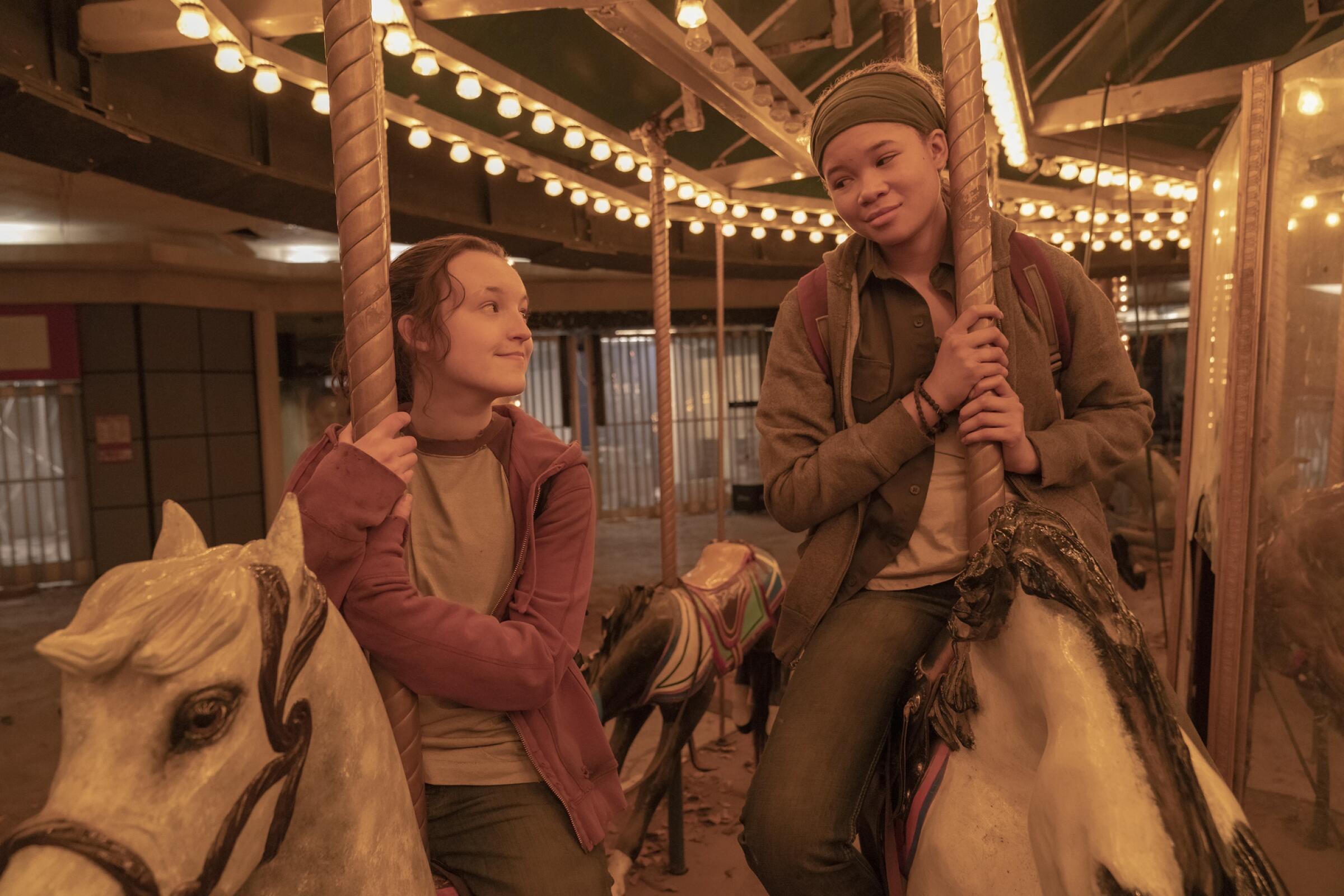
This story contains spoilers for Episode 7 of HBO’s “The Last of Us” and corresponding moments from Naughty Dog’s 2014 “Left Behind” video game.
In the brutal post-apocalyptic world of “The Last of Us,” everybody is scarred by loss.
The HBO drama launched with the image of Joel’s (Pedro Pascal) daughter getting killed during the chaos of a mutant fungal outbreak that transforms humans into mindless, cannibalistic monsters. Sunday’s seventh episode finally details the love and loss that Ellie (Bella Ramsey) lived through shortly before first meeting Joel.
With Joel seriously injured and incapacitated after the events of Episode 6, a frantic Ellie flashes back to the events that changed her life. Just weeks before she sets off on her journey with Joel, Ellie sneaks out of her dorm room at her military boarding school to spend a night out with her best friend (and crush) Riley — the same Riley that was first mentioned in the series premiere.
In Sunday’s episode, the HBO series introduces two characters from the game, Bill and Frank — and changes their story completely. Here’s why.
“I just love that this episode is focused on the younger characters’ perspectives,” said Storm Reid, who portrays Riley, during a recent video call. “It’s a little bit refreshing to see Ellie’s story … You get to see two best friends … that love each other, that care about each other. They’re two young women trying to figure it out, trying to grow up in this crazy post-apocalyptic world.”
It turns out that while Ellie has been going through the motions at school after Riley’s disappearance, Riley has dropped out to join the Fireflies — the rebel militia that opposes the oppressive military government that’s been in charge since the outbreak. To make up for her radio silence, Riley has planned an extravagant date night for Ellie at a relic of the Before Times: the mall.
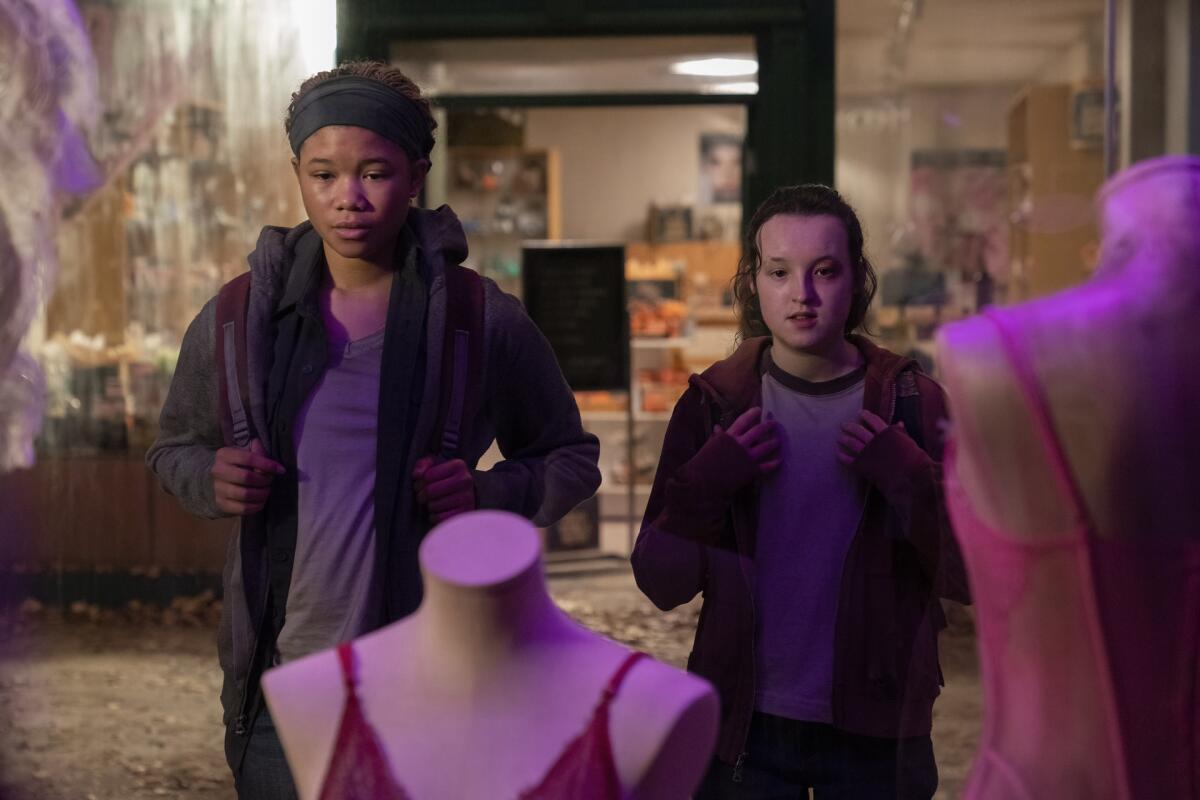
Those familiar with “The Last of Us” video games will recognize that Episode 7 is an adaptation of “The Last of Us: Left Behind,” a supplemental chapter of the game originally released in 2014. “Left Behind” was hailed for its story and for centering a queer teen romance, which was groundbreaking at the time for mainstream video games.
The “Left Behind” expansion — or DLC, in gaming parlance — jumps between the present, where Ellie scours an abandoned mall looking for medical supplies to treat a gravely injured Joel, and the past, where Ellie is hanging out at an abandoned mall with Riley.
The “Left Behind” DLC “gave a moment of fun in a really heavy world,” said Ashley Johnson, who portrays Ellie in “The Last of Us” games. “See[ing] those glimpses of [Ellie] getting to be a kid and … being carefree and those first moments of having a crush on someone. Being next to someone and [thinking] ‘Oh my God, I want to kiss them so bad.’ Her and Riley getting that beautiful moment in this really harsh world — that’s a wonderful thing.”
We trace the history of Naughty Dog’s pop culture phenomenon, from the video game’s 2013 debut to its adaptation as an HBO series 10 years later.
Though Riley’s name is mentioned in the original “The Last of Us” game, “Left Behind” marked her onscreen debut. But Riley’s official introduction preceded that — she first appeared in the prequel comic book series “The Last of Us: American Dreams,” published by Dark Horse Comics in 2013.
Written by “The Last of Us” creative director Neil Druckmann and cartoonist Faith Erin Hicks, who also illustrated the four-issue series, “American Dreams” (colored by Rachelle Rosenberg and lettered by Clem Robins) tells the story of how Ellie and Riley first meet and become friends.
Hicks — whom Druckmann was interested in collaborating with after reading her graphic novel “Friends With Boys” — says when she landed the job, she had only been told that the series would be a prequel about Ellie.
“Right at the beginning, we knew it would be set in this kind of military school where Ellie was dumped, basically, as a child, and she would meet another young woman,” said Hicks during a recent video call. “Where that would go, we didn’t know yet. So the story just sort of progressed from there.”
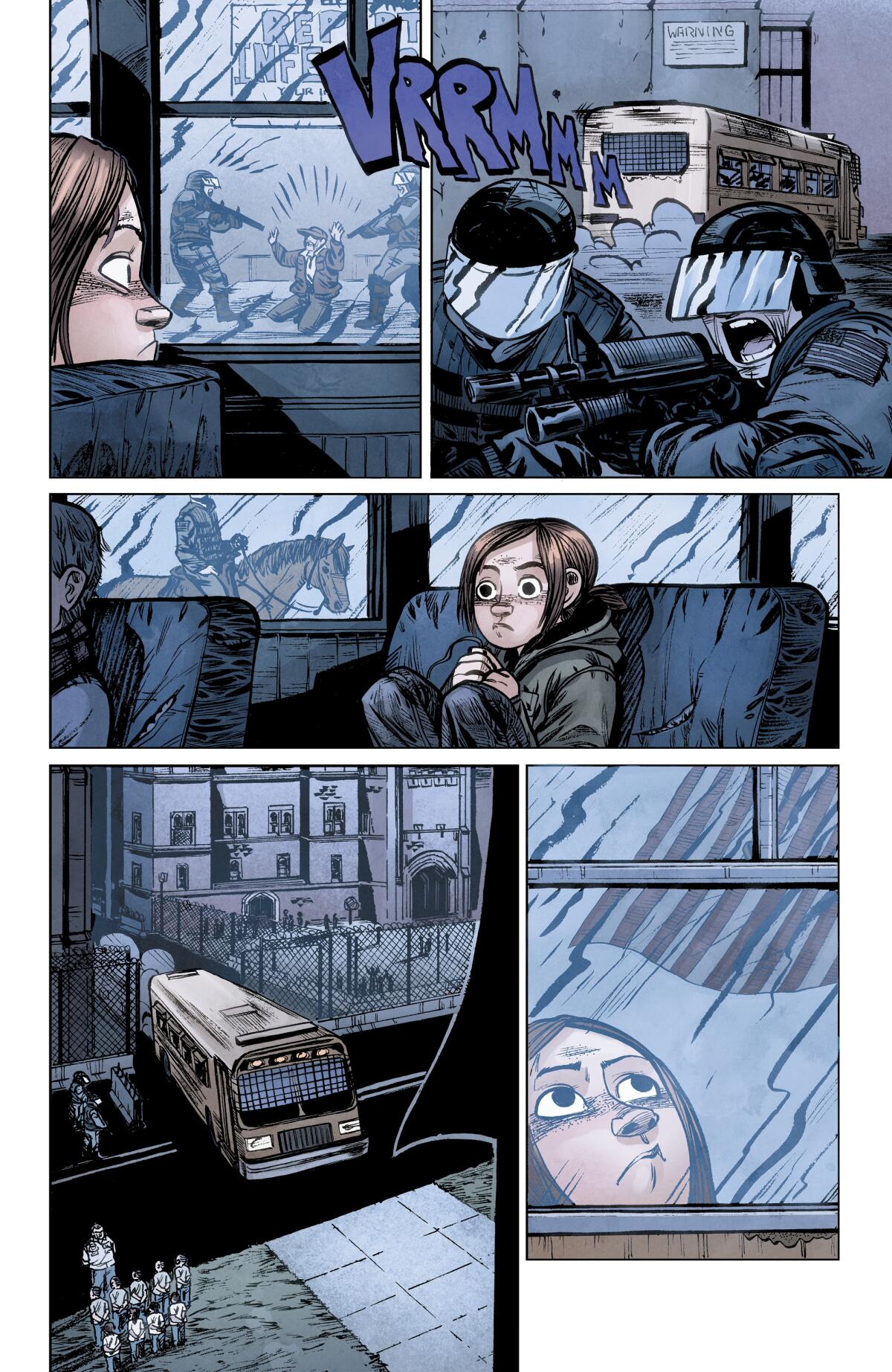
Reid described television Riley as “a young girl who’s compassionate, who is outspoken [and] who loves life, no matter the circumstance.”
“She’s badass and she is going to stand up for what she believes in and she is going to protect Ellie at all cost,” said Reid.
Hicks explained that she wasn’t given too many parameters when she was developing the character for the comic.
“Neil was basically like, ‘Ellie’s my character, I created Ellie. So you write Riley and do whatever you want,’” said Hicks, who had been shown only the game’s original script and some video sequences in preparation for the comic. “I always saw her as, like, this tough older girl, but then she starts to break apart and that very soft center is revealed. Like at the end [of the comic], she just sort of breaks down because she idolizes the Fireflies and then she discovers they’re not the people that she wants them to be.”
Riley’s visual inspiration, Hicks recalled, came by happenstance. She was watching the 2012 Olympics while drawing one day when Canadian diver Jennifer Abel appeared on TV. (Abel is also Riley’s last name.)
“I’d been doing sketches of a character that I thought might end up being Riley, kind of inspired by, like, Katniss from ‘The Hunger Games,’” said Hicks. “And then I saw this synchronized diver, this Olympic athlete, and I just found her so striking and started drawing her and then [thought], ‘Maybe this could be Riley.’ So I sent the sketches off to Neil and he really liked them.”
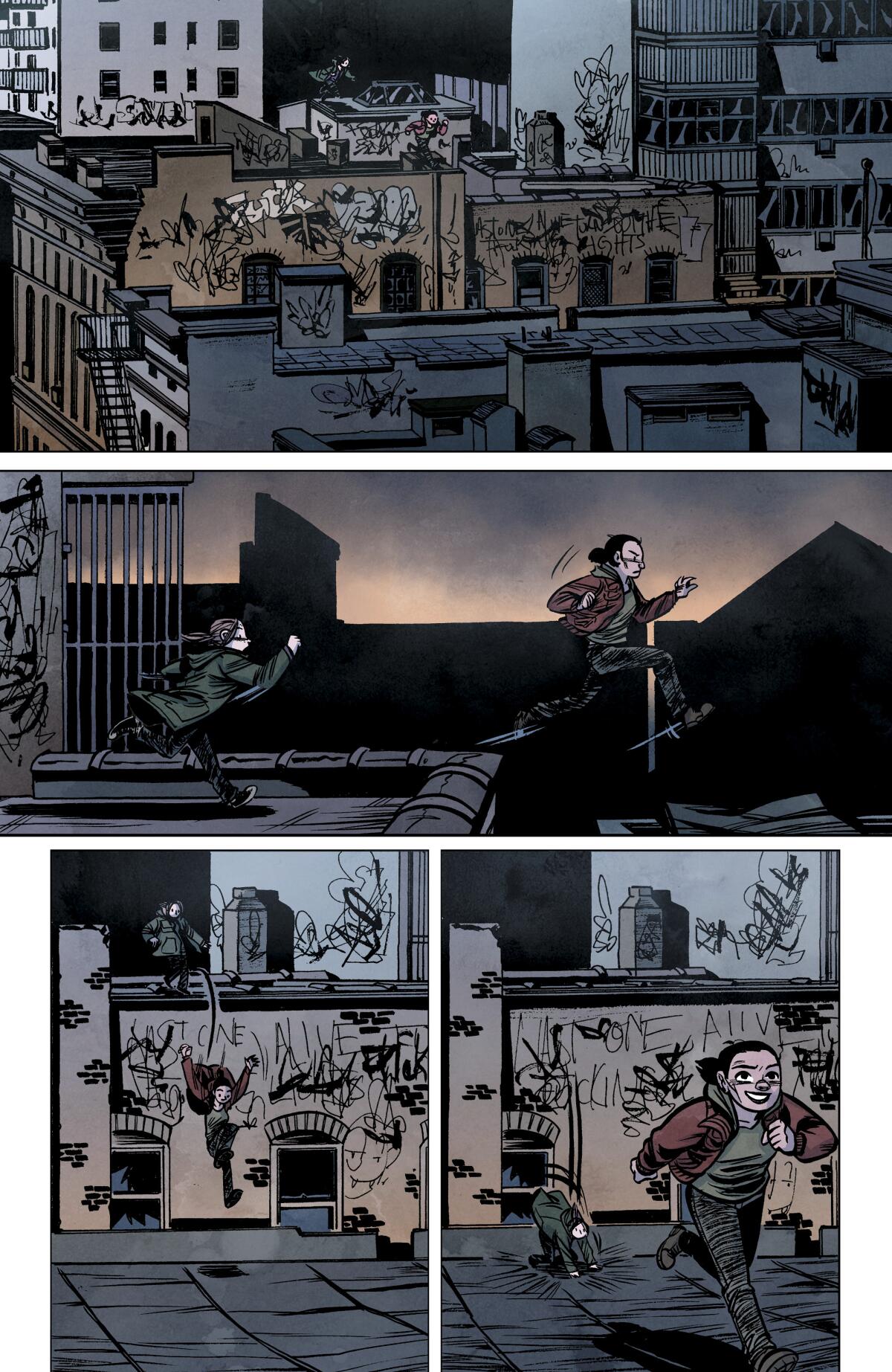
Because Druckmann and Hicks started collaborating on “American Dreams” while “The Last of Us” was still in production, elements of the comics influenced aspects of the game, including the ending. The comic also reveals the origin of Ellie’s switchblade, and how the leader of the Fireflies, Marlene, is connected to Ellie.
Druckmann, who is also co-creator and executive producer of the TV series, has mentioned in past interviews and even the featurette about the making of “Left Behind” that “American Dreams” was instrumental to the conception and creation of the expansion.
In the HBO series, Ellie is visiting the mall for the first time with Riley in Episode 7. But the abandoned mall Riley takes Ellie to in the “Left Behind” game is the same one she first showed Ellie in “American Dreams.” Even the arcade and Ellie’s interest in a certain fighting game are part of the comic’s story.
The sixth episode’s director and production designer discuss transforming a Canadian town into an Americana haven and its shocking effect on Joel and Ellie.
Hicks explained that one of the discussions she, Druckmann and other “The Last of Us” creatives had while developing the comic was about video gaming as a whole and how some of the early reactions to the game’s trailer were critical of its violence.
“We were just sort of talking about instances in our childhood history where a video game had been really brought to task for portraying violence,” said Hicks. “I remember at the time I was like, ‘Why don’t we have them go to the arcade? And they can play ‘Mortal Kombat’ and it’ll be a fun little commentary on violence in video games in the ‘90s and violence in video games in 2012-2013.’”
But, as Druckmann pointed out back then, rights issues prevented “Mortal Kombat” from appearing in the comic. So Hicks created a fictional fighting game called “The Turning” and the character Angel Knives for “American Dreams.” That arcade game appears in both the original “The Last of Us” and “Left Behind.”
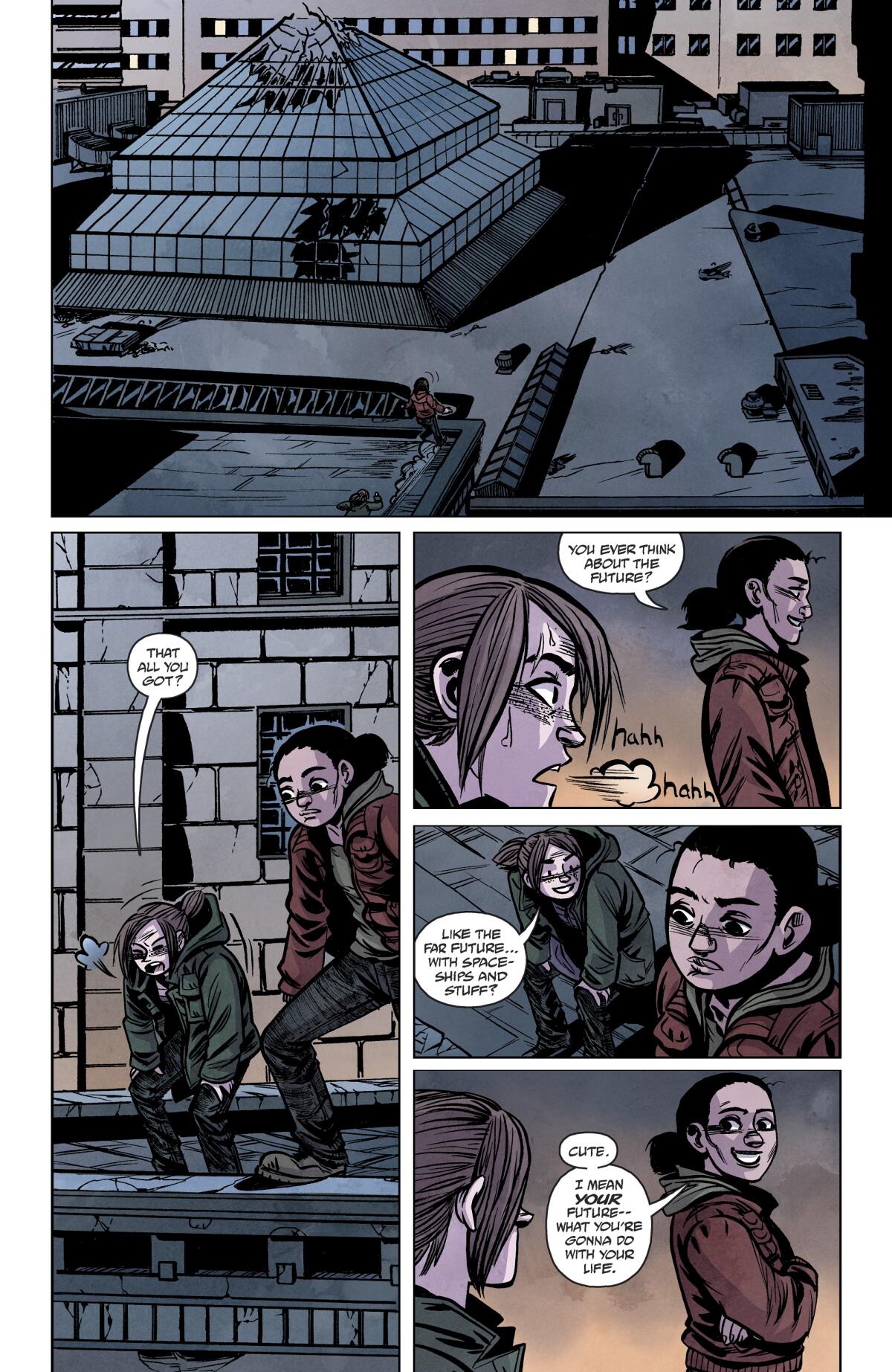
It’s fitting that in Episode 7, the game Ellie and Riley play together in the arcade is “Mortal Kombat II.” Reid, who mentioned she had never been in an abandoned mall before filming this episode, explained that the arcade scene was “really, really fun” to do.
“We [improvised] that whole scene,” said Reid. “We were really playing the game, so that was a lot of fun.”
Over the course of the episode, Riley and Ellie’s night out becomes about as cute a date as could be had in post-apocalyptic times. (Hicks laments that Ellie and Riley’s eventual romance was not something she and Druckmann had discussed when working on the comic.) And Reid appreciates how the show’s creatives “didn’t try to romanticize [Ellie and Riley’s] romance too much.”
“They just let it be young, let it be fresh, let it kind of morph into what it was,” said Reid. “But I do think Riley saw it coming a little bit … Despite her feelings and her inkling of, like, ‘Ellie might like me a little bit’ … she maybe didn’t think Ellie would have the balls to kiss her, so I think that’s the surprise.”
No doubt about it: The Starcourt Mall is, like, totally awesome.
Their budding romance is one of the reasons that makes Riley and Ellie getting attacked and bitten by infected that night at the mall even more heartbreaking. The events are crucial to understanding why Ellie’s biggest fear is ending up alone.
Still, Reid found the end both emotional and poetic, even if Ellie and Riley didn’t lose their minds together.
“I think it’s beautiful that we ended where it ends and we don’t have to see … what happened to Riley,” said Reid. “That scene is essential to bring us back to what the world [of the show] is and bring us back to [understanding] this is beautiful and they are experiencing love and they’re experiencing joy, but we are living in times where your time is cut short. We’ve seen that in different ways through each episode.”
Times staff writer Alexandra Del Rosario contributed to this report.
‘The Last Of Us’
Where: HBO
When: Sunday, 9 p.m.
Streaming: HBO Max, any time
Rating: TV-MA (may be unsuitable for children under the age of 17)
The complete guide to home viewing
Get Screen Gab for everything about the TV shows and streaming movies everyone’s talking about.
You may occasionally receive promotional content from the Los Angeles Times.